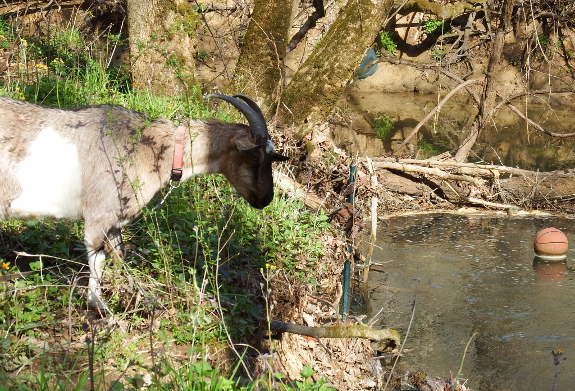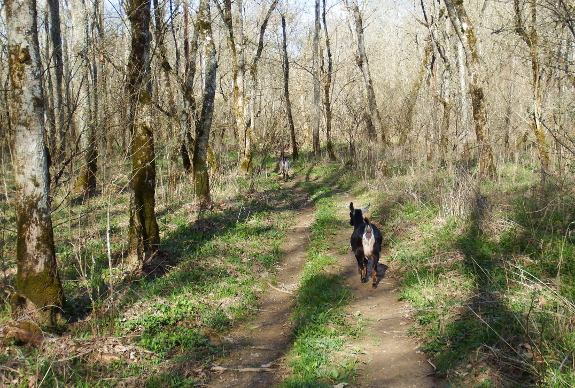
20/20 goat hindsight

Eighteen months after
buying our first goats, we're gearing up to swap out half our herd.
Abigail is going to the butcher in three weeks to be replaced by one of
Artemesia's as-yet-unborn kids. So this seems like as good a time as any
to write one of those "if I'd know then what I know now" posts to help
anyone planning to follow along in our footsteps.
Question 1: Do I buy a goat with horns or without horns?
Answer then: Either is fine. Horns are natural and beautiful.
Answer now: Hornless.
Horned goats break apart your infrastructure and beat up on their
herdmates. Abigail is on the gentle side and has never seriously harmed
Artemesia, but it's better not to risk it.

Question 2: Do I buy a cheap goat or pay the crazy prices breeders ask for a purebreed?
Answer then: I'll try one of each, but I'm not sold on purebreeds being worth the cash.
Answer now: My sample size is awfully small, but we definitely got what we paid for with each of our goats. Cheap Abigail is headstrong and makes trouble. Expensive Artemesia
is the most malleable animal I've ever worked with --- yes, including
Lucy. Maybe we got lucky, or maybe purebreeds really are the way to go.
We'll see how the sweetness carries through to the second generation.
Want more in-depth information? Browse through our books.
Or explore more posts by date or by subject.
About us: Anna Hess and Mark Hamilton spent over a decade living self-sufficiently in the mountains of Virginia before moving north to start over from scratch in the foothills of Ohio. They've experimented with permaculture, no-till gardening, trailersteading, home-based microbusinesses and much more, writing about their adventures in both blogs and books.
Want to be notified when new comments are posted on this page? Click on the RSS button after you add a comment to subscribe to the comment feed, or simply check the box beside "email replies to me" while writing your comment.

Having had goats for 3 years now (one was in milk when we got her) I have gone through some of the same kinds of thoughts.
Goats with out horns are a bit easier to deal with but with horns do give you a nice place to grab them. Our young buck (just under a year now) does have horns while the two does do not have horns. I am able to still control him and tell him I am boss. He does use the horns sometimes to push the other does around but they do the same without horns.
Purebred or cheap goats - At this point in time I would say go with Purebred goats. They are more expensive but you can sell the kids for more money which gives you another source of income and that would help pay for the upkeep of the goats. That said our ideal is a dual purpose goat - milk but also can use the kids for meat and I don't know that there is a real dual purpose breed of goat at this time.
I sort of agree with your sentiments. As a recovering goat addict, I've decided that if I ever delve back into the caprine world I will target only purebred goats for my herd. Horns are less of an issue in my opinion, most of the time. I have found that resale value is something that can't be understated. Being able to actually sell any unwanted kids or older goats and actually demand a reasonable price hinges almost solely on breeding. I have been able to sell many nigerian dwarf goats, and hybrid nigerian dwarf, and still get a substantial price. But when you have to sell a goat that is 1/4 this, and 1/4 that, and 1/2 something else, it is hard to convince people they are worth a reasonable price despite how productive they are.
I do agree that goats with horns are harder on your facilities to some degree, but if you can actually get them trained to an electric fence, this becomes much less of an issue. and despite the warnings in all the books and online articles about not grabbing them by the horns, I've never once had an issue with doing this, and there have been many occasions where I'd have had to spend five times as long corralling some wilder goats if there had been no horn to grapple. My other issue was in the process of dehorning or disbudding. In my time with goats (ten years) I've only ever come across two goats that were disbudded that didn't end up with significant scur growth. And almost all my horned goats were healthier than the hornless ones. I have wondered if this was because of the intended biological function of horns as a thermostat. check out this blog's post on dehorning: http://ourmountainhearth.com/why-we-dont-dehorn-our-goats/
just my take. but yeah, I agree on the purebred thing. Next time I'll probably bite the bullet and just buy a couple purebred does in milk. I've found that milking two goats is about the right amount of milking for me. more than that and it gets old super fast.
Julie --- After watching a couple of youtube videos, Mark and I decided we'll take the kid(s) to the vet this first time. I suspect we can learn to do it ourselves, but seeing a pro do it once seems worth the cash. But we're open to be swayed if you think that's a bad idea.
BW --- Sounds like you've come to similar conclusions! I haven't actually registered Artemesia, although I might if we decide to start selling kids. It looks like I can easily register her in the next year without paying extra. I'd have to learn to tattoo her, though, which makes me a little queasy.
Anna, That's a prudent idea. Be forewarned: nothing quite prepares you for the smell...
It's interesting to know that in Europe, disbudding is not allowed in many cases. Like ear and tail docking with dogs, Europeans like the natural look of the animal and don't like to put them through unnecessary procedures.
If you're going to take your kids to the vet to be disbudded, check to see if they will insist on anesthetizing them. If so, find another vet. Many a young kid has died from being anesthetized.
Not meaning to scare you, just sharing my experiences and food for thought.
Another Julie --- That's a very interesting bit of data! I know that I wouldn't even consider docking tails or ears for aesthetics. But disbudding seems far more functional (although equally painful for the animal in the moment).
That said, I might feel the other way if Artemesia had horns. But once you have one hornless goat, it's hard to let horned goats into the herd.
My vet always gives a few topical analgesics in the area via syringe with very young kids which I appreciate.And no doubt the kids do too. You are right, though. The submissive goats are at a real disadvantage if they are the ones in herd without horns.